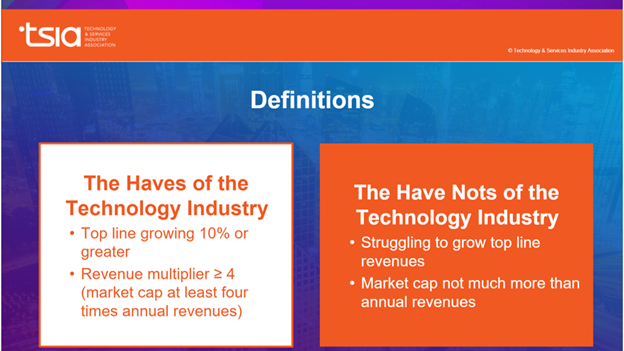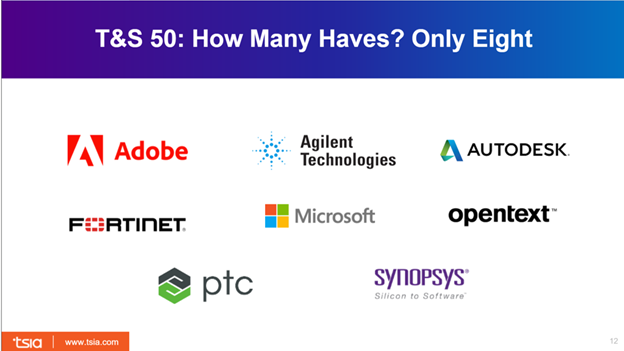Can Your Company Survive a Business Model Transformation?
Executive Director and Executive Vice President of the Technology Services Industry Association (TSIA) Thomas Lah joins us in this Q&A to discuss …
Written by

Share this post
Subscribe for best practices on optimizing your software business.
Listen to this article

Executive Director and Executive Vice President of the Technology Services Industry Association (TSIA) Thomas Lah joins us in this Q&A to discuss how some companies are set up to survive the transformation to “as-a-service” models and some are not. He lets us in on his keys to success in a cloud world – and they are probably not what you think.
I’ve had many discussions over the last two years with mid-level to senior technology execs who are frustrated and dismayed that their companies are not transforming fast enough to sell cloud-based services. And worse, many describe situations where their company doesn’t even have a vision or mandate to undertake a transformation. Their companies are anchored by inertia, still operating in silos and floundering.
The consequences for such companies are dire, as Thomas Lah, executive director and executive vice president of the Technology Services Industry Association (TSIA), points out in “The State of the Technology Industry 2021, The Haves and the Have Nots,” published Jan. 12, 2021. In referencing an index of the 50 largest technology companies (T&S 50), Thomas separates the companies into two groups: the "Haves” (those whose future looks promising) and the "Have Nots” (those whose business models are unsustainable).
Out of 50 companies, only eight are in the "Haves” group: Adobe, Agilent, Autodesk, Fortinet, Microsoft, OpenText, PTC and Synopsys. For the others, according to Thomas, “If history is our guide … less than 50% of these companies will successfully navigate a business model transformation."

Doug: Taking things to their logical conclusion, how are things apt to play out for most T&S 50 vendors that are currently in the “Have Nots” group?
Thomas: The T&S 50 is like a Dow Jones Index for the largest technology solution providers on the planet. All the companies in this index have been around for many years, which means they all started selling technology long before “technology as a service” was a thing. This reality means they are exposed by definition – they have to migrate their business models to be more “as a service” friendly or face declining revenues. Your question really boils down to this: What percentage of companies can navigate a business model transformation successfully? If history is our guide, the answer is clearly less than 50% will succeed. Having said that, old school companies in the index, like Microsoft, have migrated a majority of their revenues to new “as-service" offers. So maybe this index beats the odds.

Doug: What are some of the symptoms we're seeing right now for the “Have Nots” in terms of valuation, growth rate, budgets, consolidation and staffing? In comparison, how does it look on the other side of the fence for the “Haves”?
Thomas: There are three criteria that clearly separate the “Haves” and “Have Nots.” The “Have Nots” in the technology industry are struggling to grow revenues, their valuations barely exceed annual company revenues, and the majority of their revenue comes from selling technology as an asset that the customer has to own and operate. When these companies fixate on protecting overall company profitability in the short term, the results are very tight operating budgets and flat to declining headcount. I don’t like to shine a bright light on the companies in this category, but there are many.
The “Haves” of the technology industry are driving double digital annual growth and experiencing valuations that are five to 20 times annual revenues. This goodness is being driven by revenues from “as-a-service" offers. Companies in this category include the well-known success stories of Adobe, Autodesk and Microsoft, but also include former hardware-centric companies like Palo Alto Networks.
“If history is our guide, less than 50% of these companies will successfully navigate a business model transformation."
Doug: For the “Have Nots,” to what extent is this existential threat fully appreciated by their boards and C-suite? What do your conversations with execs of companies like this look like?
Thomas: It is funny you would ask this specific question. Right now, we are working on our next book and there is a chapter titled “The Role of Boards in Business Model Transformation.” The chapter asserts that if companies are ships, sailing in the market sea, historically, boards serve as a protective influence, similar to a sea anchor. Anchors are deployed in the open ocean to keep the ship from drifting too far from its current location. But how do Boards perform when a company needs to dramatically change course and aggressively increase the rate of change? Typically, not well. In 2012, CBS News published an article highlighting the 10 worst boards in history. Many of the boards on that list were stewarding technology companies facing business model transformation:
- Kodak, 2003
- Alcatel-Lucent, 2006
- HP, 1999
- RIMM, 2008
- Nokia, 2010
When it comes to business model transformation, there are two reasons boards can struggle:
- Lack of vision
- Lack of relevant expertise
With lack of vision, the board is unclear what the new business model could look like for the company. There is no definition of future success. What is the company running toward?
With lack of relevant expertise, the board has experience that is applicable to the old business model, but not the new model. So there is a reason mid-level management at tech companies are frustrated. And yes, they are correct – their boards and executive teams are moving too slowly!
Doug: To what extent are “Have Not” companies now embracing the kind of digital transformation and other changes urgently required to not get left behind?
Thomas: This goes back to the core question asked earlier: What percentage of tech companies turn the bend on this specific business model transformation? Again, history tells us a majority of “Have Not” companies will become irrelevant. I think the big question for your readers is to be realistic about the state of their current company. Is my company embracing the kind of change required to survive and thrive? Ask and answer these questions:
- Does my company have any compelling XaaS offers?
- Does my company have specific targets for how much revenue will come from new XaaS offers over the next three to five years?
- Is my company investing in building out the capabilities required to support an XaaS business model?
If the answer is “no” to all three of these questions, you have three options:
- Successfully agitate for change
- Change companies
- Continue to work for a company that is in slow motion liquidation
Doug: You identified seven Critical Attributes of Success (e.g., Signal Liquidity) for technology vendors. What are some critical things in terms of leadership, strategy, organizational alignment, KPIs, etc., that legacy technology companies must put in place to lay the groundwork to successfully move in the right direction? Who has done this right and what lessons can we infer?

Thomas: OK, the response to that question fills up the last two books we published AND the current one we are writing! But let’s review the recommended steps technology companies should navigate as they transform their business model:
EDUCATE
In this phase, the management team and board of directors need to educate themselves on the nuances of a XaaS business model. Executives should be reading everything they can about stewarding a business model based on recurring revenues. Exemplars should be studied and discussed. Successful, smart leaders are confident they can learn quickly, which is true. It is the volume of new knowledge they underestimate. We have seen this phase last anywhere from months to two years. If management teams skip this phase, they enter the next phase handicapped.
RECRUIT
It is clear that companies having success in this transformation are recruiting outside talent that has experience with XaaS business models. This recruitment phase can result in a new CEO, new board members, or simply new leaders responsible for developing XaaS offers.
ALIGN
This phase is all about aligning key stakeholders to the journey ahead. There are two lessons to be learned by observing companies that are struggling with this transformation:
- Don’t underestimate the time and effort required to align stakeholders.
- Get the board on board during this phase.
At the end of this phase, all stakeholders should have the same answer for the following questions:
- What is the primary reason we are pursuing new XaaS offers?
- What percentage of total company revenues do we expect to come from XaaS offers three years from now?
- Why will customers buy our new XaaS offers?
- What gross margin do we expect to achieve from our new XaaS offers?
ASSESS
In this phase, a management team assesses capability gaps. Once gaps are identified, the team determines the order that gaps will be closed. Think in terms of waves. Wave one capabilities, wave two capabilities, wave three capabilities.
INVEST
In this phase, management teams should be making the following moves:
- Make the organizational structure changes required to support the new business model.
- Recast the budget to support the development of the capabilities identified in the previous phase. Assess and pursue potential acquisition targets that could accelerate the transformation.
- At the end of this phase, the company is well positioned to aggressively execute on the transformation.
ANNOUNCE
Now, and only now, is a company truly prepared to announce their transformation aspirations. From this moment forward, the executive team should relentlessly communicate (internally and externally) the success metrics of the new business model.
REINFORCE
In this phase the leadership team is reminding all key stakeholders of the following:
- The reasons why the company is pursuing the transformation
- The success metrics of the transformation
- The status of the transformation
- Reward good behavior and punish bad behavior
DECLARE
Finally, when the new success metrics are being met and real progress can be demonstrated, the company can declare transformation victory. Again, there is a growing list of companies that have navigated this journey extremely well. There is hope!
Doug: How can the leaders and change agents within legacy technology companies (e.g., T&S 50), successfully engage their internal peers and leaders in the kind of work required to successfully transform their businesses to be able to join “The Haves”?
Thomas: This is a great question. I stated a Lah’s Law several years ago:
Unsustainable business models are unsustainable. Companies do not abandon unsustainable business models until they are unsustainable.
My experience is that key stakeholders need to internalize that the required business transformation is non-negotiable. Anything less than that belief and leaders transgress to their current priorities and behaviors. Job number one is to verify that all the key stakeholders within the company truly believe the business model must transform.
About Thomas
Thomas Lah is the executive director and executive vice president of the Technology Services Industry Association (TSIA), the leading association for today's technology and services organizations. He is the author of many popular books on trends affecting the tech industry, his latest being Technology-as-a-Service Playbook: How to Grow a Profitable Subscription Business. For over 20 years, he has been helping some of the world's largest technology companies improve the efficiency of their daily operations.
View Thomas’ full bio here. Find Thomas on LinkedIn.


